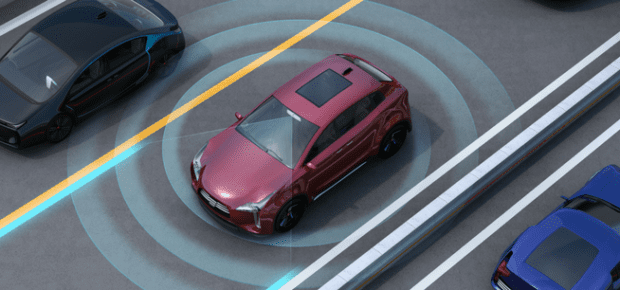April 11, 2017
The last 18 months have been very exciting for autonomous vehicle technology. New self-driving car prototypes have been taking to the streets, a growing number of companies have announced initiatives and collaborations to pursue activities in the autonomous vehicle space, and state governments across the nation are working on legislation for allowing autonomous vehicles to travel on public roads. Innovations in sensor systems, embedded processor technology, navigation, automatic control, and real-time decision making (via mechanisms such as machine learning and neural networks) have collectively resulted in autonomous vehicle platforms that may potentially enable the safe operation of these highly complex systems.
Until now, almost all developments and on-road experimentation with autonomous vehicles have been conducted with the assumption that these platforms are operating in isolation. Sure, there are several companies that have been testing their autonomous vehicle platforms on public roads over the past year. However, in some of those instances, the public roads are far off in isolated, trafficless areas that do not resemble real-world driving scenarios. In other cases where autonomous vehicle platforms are actually immersed in road traffic, these autonomous vehicles are not really “interacting” with surrounding cars, bicycles, buses, and other road vehicles. Instead these autonomous vehicles drive in virtual isolation, traveling along at 25 MPH, while the real-world traffic zips by.
While we have made significant progress in the development of new autonomous vehicle technology, we still have some work to do to make autonomous vehicle technology an integral part of the public road traffic landscape. Given these advances in autonomous vehicles, one should ask: What is holding us back? Sensor systems, decision-making systems, embedded processors, control algorithms, and other key components for driverless cars have all made significant progress in terms of maturing into reliable technologies relative to 20 years ago. What’s missing? The answer:wireless connectivity.
Looking at how society currently takes to the roads, we can make the following important observation: all human drivers are communicating with each other. Although we make decisions on how we are driving our vehicle based on the environmental information that surrounds us, such as the condition of the road surface, visibility, and prevailing traffic flow, human drivers also “communicate” with each other directly. Examples of driver-to-driver communications include: using turning signals to indicate intentions to change lanes or make a left/right turn, waving a car along to make that turn, or flashing high beams to warn approaching cars of an upcoming hazard, such as a herd of deer on the road.
From an autonomous vehicle perspective, wireless communications between vehicles possesses significant benefits in providing driverless cars with an additional dimension of information that ensures that their driving decisions are the most appropriate given the prevailing road conditions.
Although there has been a significant amount of innovation and advances in the wireless communications and networking sector over the last half century, there still exists a substantial amount of work to apply wireless technology to autonomous vehicles. Specifically, the following three items are open research areas that require solutions to help truly make autonomous vehicles a reliable and safe reality:
- Choosing the right wireless technology to establish links between cars
- Defining efficient, low-latency vehicular networking architectures
- Securing connected autonomous vehicles from cyber attacks
There is currently a debate within the wireless community with respect to which communications technology would be suitable for connecting vehicles to each other. Some advocate for DSRC (Dedicated Short Range Communications), a communications standard supporting vehicular networking across 75 MHz at 5.9 GHz. Others have proposed using 5th Generation (5G) cellular communications for connecting vehicles. Both proposed approaches have their pros and cons, and it will take some time to form a viable solution that can be deployed on the road.
The term “V2X” is being used to describe the wireless connectivity of vehicles to either other vehicles, or roadside infrastructure such as traffic signals and road signs. Although there have been several proposed vehicular networking architectures, there are a plethora of practical considerations that need to be accounted for, ranging from the highly dynamic transmission environment that affects network topology to legislative considerations with respect to installing wireless devices on public infrastructure such as signage, roadways, lamp posts, etc. In the next several years, the wireless community will find out first-hand how these practical considerations may significantly affect the design of these vehicular networking architectures.
Securing connected autonomous vehicles is an issue that needs to be addressed sooner rather than later. The typical vehicle possesses 70 or more embedded processing systems, each performing a specific operation (some of which are critical). Over the past five years, it has been demonstrated how cyber attacks can be performed on these typical vehicles to disrupt their operations. Hackers can compromise the security of a vehicle via Bluetooth or the Tire Pressure Monitoring System (TPMS), taking out systems such as the brakes or the automatic transmission. The traditional security approach for vehicles, namely using a key or a keyless entry system (FOB), is no longer relevant. Imagine an autonomous vehicle that is loaded up with embedded processors, and connected to the world via different wireless links. We effectively have a networked computer on wheels, which an individual with enough time and skill can learn to hack. Devising solutions for automotive cyber security is an urgent need that requires immediate attention.
It is great to see that autonomous vehicle technology is taking off, but there is still much work to be done to make these platforms a mainstream component of today’s transportation landscape. By connecting these autonomous vehicles to each other and the Internet in a reliable, low-latency, and secure manner, we can ultimately achieve the deployment of a technology that only a few decades ago was considered science fiction.
Alexander M. Wyglinski, Ph.D., is an IEEE Senior Member and Associate Professor at the Department of Electrical and Computer Engineering, Worcester Polytechnic Institute, Worcester, MA. He has taught short courses and presented tutorials around the world across a wide range of topics, from wireless communications to cyber-physical systems, for both industrial and academic audiences.





 Liquid Infrastructure: Our Planet's Most Precious Resource
Liquid Infrastructure: Our Planet's Most Precious Resource The Impact of Technology in 2025
The Impact of Technology in 2025 Quantum and AI: Safeguards or Threats to Cybersecurity?
Quantum and AI: Safeguards or Threats to Cybersecurity? Why AI Can't Live Without Us
Why AI Can't Live Without Us Bits, Bytes, Buildings and Bridges: Digital-Driven Infrastructure
Bits, Bytes, Buildings and Bridges: Digital-Driven Infrastructure Impact of Technology in 2024
Impact of Technology in 2024 Emerging AI Cybersecurity Challenges and Solutions
Emerging AI Cybersecurity Challenges and Solutions The Skies are Unlimited
The Skies are Unlimited Smart Cities 2030: How Tech is Reshaping Urbanscapes
Smart Cities 2030: How Tech is Reshaping Urbanscapes Impact of Technology 2023
Impact of Technology 2023 Cybersecurity for Life-Changing Innovations
Cybersecurity for Life-Changing Innovations Smarter Wearables Healthier Life
Smarter Wearables Healthier Life Infrastructure In Motion
Infrastructure In Motion The Impact of Tech in 2022 and Beyond
The Impact of Tech in 2022 and Beyond Cybersecurity, Technology and Protecting Our World
Cybersecurity, Technology and Protecting Our World How Technology Helps us Understand Our Health and Wellness
How Technology Helps us Understand Our Health and Wellness The Resilience of Humanity
The Resilience of Humanity Harnessing and Sustaining our Natural Resources
Harnessing and Sustaining our Natural Resources Creating Healthy Spaces Through Technology
Creating Healthy Spaces Through Technology Exceptional Infrastructure Challenges, Technology and Humanity
Exceptional Infrastructure Challenges, Technology and Humanity The Global Impact of IEEE's 802 Standards
The Global Impact of IEEE's 802 Standards Scenes of our Cyber Lives: The Security Threats and Technology Solutions Protecting Us
Scenes of our Cyber Lives: The Security Threats and Technology Solutions Protecting Us How Millennial Parents are Embracing Health and Wellness Technologies for Their Generation Alpha Kids
How Millennial Parents are Embracing Health and Wellness Technologies for Their Generation Alpha Kids Space Exploration, Technology and Our Lives
Space Exploration, Technology and Our Lives Global Innovation and the Environment
Global Innovation and the Environment How Technology, Privacy and Security are Changing Each Other (And Us)
How Technology, Privacy and Security are Changing Each Other (And Us) Find us in booth 31506, LVCC South Hall 3 and experience the Technology Moon Walk
Find us in booth 31506, LVCC South Hall 3 and experience the Technology Moon Walk Virtual and Mixed Reality
Virtual and Mixed Reality How Robots are Improving our Health
How Robots are Improving our Health IEEE Experts and the Robots They are Teaching
IEEE Experts and the Robots They are Teaching See how millennial parents around the world see AI impacting the lives of their tech-infused offspring
See how millennial parents around the world see AI impacting the lives of their tech-infused offspring Take the journey from farm to table and learn how IoT will help us reach the rising demand for food production
Take the journey from farm to table and learn how IoT will help us reach the rising demand for food production Watch technical experts discuss the latest cyber threats
Watch technical experts discuss the latest cyber threats Explore how researchers, teachers, explorers, healthcare and medical professionals use immersive technologies
Explore how researchers, teachers, explorers, healthcare and medical professionals use immersive technologies Follow the timeline to see how Generation AI will be impacted by technology
Follow the timeline to see how Generation AI will be impacted by technology Learn how your IoT data can be used by experiencing a day in a connected life
Learn how your IoT data can be used by experiencing a day in a connected life Listen to technical experts discuss the biggest security threats today
Listen to technical experts discuss the biggest security threats today See how tech has influenced and evolved with the Games
See how tech has influenced and evolved with the Games Enter our virtual home to explore the IoT (Internet of Things) technologies
Enter our virtual home to explore the IoT (Internet of Things) technologies Explore an interactive map showcasing exciting innovations in robotics
Explore an interactive map showcasing exciting innovations in robotics Interactively explore A.I. in recent Hollywood movies
Interactively explore A.I. in recent Hollywood movies Get immersed in technologies that will improve patients' lives
Get immersed in technologies that will improve patients' lives